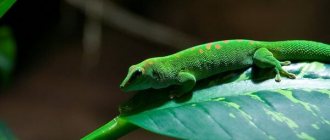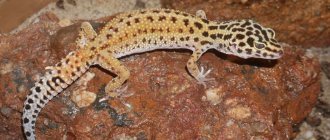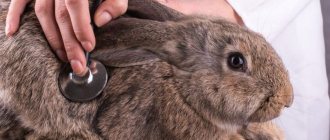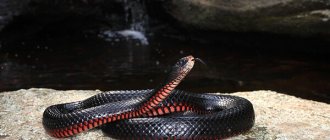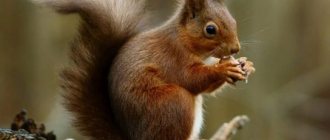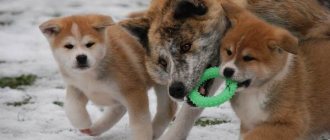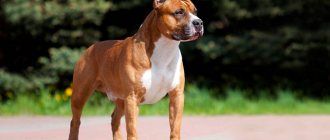Leopard geckos are a genus of lizards from the leopard gecko family. Many exotic pet lovers keep beautiful reptiles at home. They are easy to care for, but there are still some nuances of keeping leopard geckos that novice owners should familiarize themselves with.
In the article we will talk about the features of keeping and caring for a leopard gecko at home, what varieties exist, what kind of terrarium is needed, how to properly equip it, what to feed your pet, what vitamins it needs, how often does molting occur, breeding leopard geckos, the main diseases and their symptoms.
Types of leopard geckos and features of their behavior
There are five main varieties of the leopard gecko genus: Spotted, Turkmen, Afghan, Iranian and Hardwick's. The most popular are Spotted leopard geckos, which are often kept in special terrariums at home. These lizards have an unusual appearance and are attractive with their beautiful leopard-print coloring.
Spotted leopard geckos are calm and docile pets. They are absolutely not aggressive, quickly get used to people and are very attached to their owner. They make easy contact with small children. Parents should not worry, the smart lizard will not offend the child. They also often ask to be held by their owner and can fall asleep right on the palms of their hands, like cute kittens.
Other types of leopard geckos are rarer inhabitants of home terrariums. Turkmen lizards are a very rare species listed in the Red Book. Iranian leopard geckos are distinguished by their large body size and long legs. Representatives of the Hardwick genus have reddish-brown stripes on their backs. Afghan lizards belong to a subspecies of the Iranian breed.
Leopard geckos have a friendly character, but they do not show it right away. In the first days after purchase, they may seem slightly aggressive, which is associated with stress and adaptation to someone else's home. However, within a few days the lizard will get used to its new habitat and show its kind and flexible character.
In the wild, leopard geckos live alone, but a couple of reptiles can be kept in a terrarium. The main thing is that they are of different genders. Two males will not take root in the same territory; they will constantly fight and divide common possessions among themselves. But two females may well become friendly neighbors.
Habitat
Spotted leopard geckos are distributed from Afghanistan to western India. They choose rocky foothills and sandy areas, but often live in semi-fixed sands. Lizards avoid open desert places because they feel uncomfortable there.
Lizards prefer to be nocturnal and stay in shelters during the daytime. Under natural conditions, spotted leopard geckos live in small colonies, including 1 male and several females. The male individual defends his territory. In nature, males live 8-10 years, single females - 5-8. In nature, the leopard gecko hunts various insects.
Pros and cons of keeping at home
The leopard gecko is an exotic pet with interesting behavior and a friendly character. Keeping this unusual pet at home has its pros and cons. Let's look at them.
Pros:
- do not cause allergies, as is often the case with cats and dogs;
- cute, calm and clean animals;
- curious and smart;
- do not require overexposure, you can safely leave the lizard alone for several days when going on vacation;
- unpretentious in care;
- quickly adapt to a new home and get used to the owners.
Minuses:
- they feed on food insects, you will have to buy them in specialized pet stores, since feeding lizards with crickets and cockroaches caught on the street is strictly unacceptable;
- They lead a nocturnal lifestyle, so the most interesting moments of a lizard’s life can only be observed in the dark.
Genetics
Eclipse, a recessive trait that can have several signs, they in turn affect not only the color of the eyes, but also the color of the leopard gecko as a whole, muting bright shades, splitting spots and changing the pattern. Each of these traits can manifest itself either individually or together with others. (see features)
Eclipse is not related to Marble eye and Noir Desire. Since all three morphs are responsible for different genes that act in a similar way, changing eye color.
Crossing Eclipse with Marble eye and Noir Desire produces babies with normal eyes.
Eclipse can produce an eye pattern similar to Marble eye, but is not related to the gene of the same name.
Selection and arrangement of a terrarium for the leopard gecko
To be kept at home, the leopard gecko needs a cozy home. The ideal option would be to buy a terrarium. However, it is also considered acceptable to keep a lizard in a capacious plastic container, equipped with everything necessary for a comfortable life for an exotic pet.
Size and material of manufacture
Since plastic containers have cloudy walls, which does not allow convenient observation of the life activity of the leopard gecko, many people opt for a terrarium.
The optimal size of the tank for one reptile is 40x30x30 cm or 35x35x35 cm, for two - 50x40x40 cm. The terrarium should have a rectangular or square shape. Product material: wooden or plastic frame, transparent glass walls. Terrariums with side sliding doors are very easy to maintain.
Temperature
Leopard geckos are cold-blooded lizards that thrive at room temperature. The optimal air temperature in the terrarium is 23-260C.
Lizards, accustomed to moving in the wild on hot surfaces, need warm soil. To heat it, you can use a special thermal mat placed under the bottom of the tank. The heating element should cover no more than 1/3 of the floor area.
There should be an unheated area of soil left in the terrarium so that the pet can independently choose - to bask in a warm place or sleep in a pleasant coolness. The maximum soil heating temperature is 320C. You can control the temperature using a special soil thermometer.
Lighting and heating
Leopard geckos are nocturnal, so natural light during the day will be enough for them. If the terrarium is located in a dark corner, you can equip it with a special lamp with a power of up to 30 W.
To synthesize vitamin D3, the leopard gecko needs ultraviolet light, so an ultraviolet lamp can also be used as an additional light source. But placing the terrarium in direct sunlight is strictly prohibited. Sunlight will strongly heat the walls of the tank, creating an uncomfortable air temperature inside.
A thermal mat is successfully used as a heat source in a leopard gecko terrarium, heating the soil and creating a pleasant microclimate inside the container. As an alternative, you can use a heating cord.
Humidity and ventilation
In a terrarium with a leopard gecko, there must be ventilation holes in the lid or in the side walls of the tank to provide a flow of fresh air.
As for humidity, the optimal value for lizards of this species is 50%. During the cold season, when the heating is turned on in the house, the air becomes excessively dry. To create a comfortable level of humidity in the terrarium, it is recommended to periodically spray the soil with cool water. You can also place a damp substrate or coconut shavings at the bottom of the tank, which humidifies the air well.
To measure the humidity level in the terrarium, use a special device - a hygrometer.
Soil and plants
In order for the leopard gecko to live comfortably in a closed tank, it is necessary to create the right conditions inside the terrarium, close to the natural environment. The bottom of the container is filled with soil. This can be coconut fiber, soft stones and pebbles, large sawdust, tree bark or sphagnum moss.
Some areas can be filled with cleaned and sifted sand, but be sure to observe the lizard's behavior. In nature they do not eat sand, but at home they often absorb it. In such cases, it is better to remove the sand, as it can cause clogging of the stomach and death of the pet.
Special decorative coverings for terrariums are considered the safest for leopard geckos. They are sold in pet stores. Such products perfectly imitate the natural habitat, and they are also easy to clean from various contaminants and are absolutely safe for exotic pets.
You can use live or artificial plants to landscape the area where the leopard gecko lives.
What plants are suitable for arranging a terrarium:
- haworthia subshrubs;
- sansevieria;
- aloe;
- Adromiscus;
- gasteria;
- small species of agave;
- Crassula.
Living plants create a natural atmosphere in the terrarium, stabilize the microclimate and reduce fluctuations in air humidity. Potentially dangerous poisonous plants, as well as cacti and other thorny species of flora, should not be used in interior decoration.
Shelters and decor
Lizards love to hide, so it is imperative to create hiding places in your home terrarium. These can be large stones, bamboo tubes, tree bark and other natural elements. The main thing is to secure them tightly so that a foreign object does not accidentally injure the lizard.
At the pet store you can also purchase beautiful decorative elements and shelters for arranging a terrarium. The assortment includes a large selection: artificial skulls of large animals, caves, grottoes, natural coconut houses, vine trunks, polymer cacti with minks and much more.
Genetic drift (genetic drift)
Genetic drift is most pronounced in those populations in which the number of individuals is not large (see Fig. 2). In such a mini-population, a process of decreasing the percentage of any allele (an allele is a section of a gene responsible for a certain trait) up to its complete loss is very likely. In this case, a predominance of another allele will arise in this group of animals. This phenomenon is called genetic drift.
Consider the example of genetic drift. Albinos occur in nature. Albinism occurs when the alleles associated with the phenotype are mutated. But with such a phenotype (albinism), animals turn out to be weaker physically. Such animals are less likely to survive and reproduce. Therefore, the number of animals with such an allele decreases until it completely disappears from the population. Conversely, those alleles that contribute to survival in natural conditions become fixed in the population. So, for example, the bright color of males, which attracts females, allows such an allele to be “fixed” in the population, because they are popular with females, they will produce more offspring, and such a brightly colored allele becomes predominant in the population. At the same time, the percentage of individuals with a different allele decreases until they disappear completely.
Figure 2. Here we see an isolated population located in one place (a bank), which means that gene flow from other populations is excluded.
Let the red balls represent an allele that negatively affects the metabolism and survival of individuals. Therefore, the presence of this “red” allele has a negative effect on reproduction. The number of animals with this allele is decreasing and fewer and fewer of them take part in reproduction.
Passing from generation to generation (bottle to bottle, from left to right), eventually the red allele is lost, and the blue one becomes fixed in that group.
Many factors contribute to genetic drift in nature, such as fitness, which is associated with different alleles.
In our case, when breeding new morphs of spotted leopard geckos, we artificially select those individuals that carry the characteristics we need: color, brightness, presence or absence of spots, etc. By selecting and crossing such leopard geckos with each other, we “cleanse” the alleles with other characteristics so that in our selection group of animals only individuals carrying the alleles we need remain.
Feeding leopard geckos
The main diet of domestic leopard geckos are insects of various species. The favorite delicacy of lizards is crickets. You can also include grasshoppers, locusts, green caterpillars, mealworms, and Madagascar cockroach larvae on the menu. Sometimes you can feed leopard geckos with newborn mice, but often you should not give such food.
Exotic lizards do not eat vegetables, fruits and greens. For them, protein foods are more acceptable than plant foods. You should also not feed your leopard gecko maggots and earthworms.
How to properly feed your home leopard gecko:
- Food is served from tweezers or from the hand.
- It is better to give food in the early morning hours or in the evening, during periods when the pet is awake.
- In the first month of life, lizards are fed 2 times a day. Single serving – 1 cricket or other insect.
- 2-3 month old leopard geckos eat 2 crickets at a time. At this age they are fed once a day.
- From 4 to 6 months inclusive, food is given to the lizard every other day. Single serving – 4-5 insects.
- From 7 to 12 months of life, leopard geckos are fed 3 times a week. Single serving – 6 large crickets.
- Feeding regimen for lizards from one year of age: 3 times a week, 10 large insects at a time.
However, leopard geckos are not prone to overeating and obesity, so you don’t have to worry that the selected dose of food will be unnecessary. This pet knows its norm and body needs well.
Insects for feeding the leopard gecko need to be purchased in specialized stores!
What vitamins does a lizard need?
Periodically, the leopard gecko needs to be fed with useful vitamins and mineral supplements. Their body especially needs calcium, which must be freely available to the pet in the terrarium. It can be purchased at the store in powder form and poured into the feeder.
In addition to calcium, you can feed your leopard gecko with special vitamins - “Repashi”, “Rep-Kal multivitamins” and other ready-made complexes are always available in the assortment of pet stores. On the packaging, read the instructions about the dosage and recommended frequency of feeding your pet with useful compounds.
Why is it important to preserve genetic diversity in animal lineages?
Preservation of genetic diversity serves to prevent alleles from disappearing from a population due to genetic drift and constant inbreeding. This is necessary for the survival of any species. There are several things that need to be considered to appreciate how quickly inbreeding can lead to negative consequences when developing new leopard gecko morphs. Typically, for species with short generation times (i.e. those that reach sexual maturity quickly, such as leopard geckos), this can happen quickly. However, for species with a relatively long generative period (slowly reaching maturity, for example, turtles), the negative effect is not so pronounced.
The reason we can see effects more quickly in fast-maturing species is because their generations are short and you can get 15 generations in 15 years. Turtles will need much more time for this (depending on the type of turtle), so we simply do not have time to notice the manifestations of inbreeding and genetic drift.
Breeding leopard geckos at home
By 9-12 months of life, leopard geckos reach sexual maturity. Males, unlike females, have a large head, a massive tail and larger body sizes. The mating season for lizards living in captivity begins in November and ends in March.
To breed lizards in a terrarium, it is necessary to create suitable conditions for mating games. One male and 3-4 females are placed in the tank. Daylight hours should be increased to 14-15 hours, and it is also necessary to create a hotter air temperature by increasing heating to 28-300C. The humidity level should be increased to 60-80%. This microclimate stimulates lizards to engage in mating games.
About three weeks after mating, the female lays eggs in the ground and buries them. During one mating season, she can make up to 10 clutches of 1-2 eggs. The ripening period for eggs is about 2 months.
Interesting fact: the ambient temperature can predict the gender of babies born. If you maintain the soil temperature within 260C, more females will be born, and at a temperature of +310C, predominantly males are born. And if you maintain the temperature in the range of +29-300C, the number of males and females born will be approximately the same.
Newborn leopard geckos weigh 5-9 g, and their body length reaches 6-8 cm. Babies have a pale striped skin color, and only by 7-8 months of life do they acquire a real adult color.
To care for newborn leopard geckos, you need to prepare incubators. You can make them from plastic containers. Thick napkins or paper towels are used as bedding.
Small lizards grow quickly. They are fed small insects and calcium is used as a supplement. Every 2-3 days in a terrarium with newborns you need to turn on the ultraviolet lamp (literally for a couple of minutes).
The babies can live together for the first 3-4 months, but after that they need to be housed. Already at this age, a male can fertilize a female, but she will not yet be ready for such early motherhood.
Strict control
There are also other aspects to breeding projects that must be taken into account and executed carefully. Compliance with all rules for the care and breeding of your lizards is a priority. It is necessary to observe temperature conditions both when keeping geckos and when incubating eggs. It is very important to meticulously track each egg.
During the breeding season, large breeders produce many eggs at once. And if these eggs are incubated together, it can sometimes be difficult to determine which babies are from which line of leopard geckos. Therefore, separate breeding of different lines is more reliable in breeding practice. It is best to incubate the eggs of different females separately. Additionally, these eggs should be carefully marked. This allows you to know the exact origin of each egg and when the young hatch, the breeder will know the exact genetics of each lizard.
In addition to the fact that the breeder can trace the pedigree of each gecko, if interesting characteristics suddenly appear in this generation of leopard geckos, the breeder will be able to reproduce the results. At the same time, it is necessary to carefully monitor the incubation process in order to avoid accidental temperature fluctuations, which can also affect the appearance and health of the new generation.
How often does shedding occur?
Baby leopard geckos shed every two weeks, and adults no more than once every 1-2 months, and this process often depends on external conditions.
Molting can be determined by characteristic signs: the lizard’s skin becomes lighter, peeling and cracks appear. The leopard gecko can eat the shed skin, and this is not dangerous to its health and life.
During the molting period, it is recommended to install a damp chamber or substrate in the terrarium to moisturize the skin, which promotes its rapid renewal.
Description of the morph
Eclipse is a recessive trait that appeared in 2004.
Was obtained by Ron Tremper as part of the RAPTOR project. The morph's name translates to "Eclipse" because of its effect on the shading of geckos' eyes, but it also affects coloration. Eclipse is one of the basic morphs and its influence on color is quite wide, which allows you to get interesting combinations and colors.
Eclipse
Eclipse
Possible diseases of leopard geckos
Leopard geckos, like any other living beings, are susceptible to certain diseases that arise for a number of reasons.
The most common diseases of leopard geckos:
- Helminthiasis is infection by helminths. The pathology worsens with exhaustion and severe stress. Characteristic signs are refusal to eat, loose stools with a foul odor, and a decrease in the volume of the tail. Treatment is carried out with special anthelmintic drugs for lizards. It is also recommended to drink plenty of fluids to avoid dehydration.
- Rickets. The disease develops due to a lack of calcium in the body. An obvious sign is deformation and weakness of the legs; the lizard moves slowly and touches the ground with its belly. The treatment uses liquid calcium gluconate. Drops of the drug are instilled into the lizard's mouth every day for 2 or more months. Special foods containing calcium must be included in the diet.
- Fungal diseases in which grayish spots appear on the skin of the leopard gecko. Treatment is carried out only as prescribed by a doctor.
- Cryptosporidiosis is a very dangerous and practically incurable disease that affects the liver and causes the accumulation of large amounts of fluid in the abdominal cavity. With this disease, the lizard's tail noticeably loses weight, and a black spot appears on its chest. In this case, emergency assistance from a specialist is required.
- Unsuccessful molting, after which the lizard's tail becomes flabby and its tip dry. The problem can be solved simply: the diseased tail is carefully cut off, and the wound is treated with Miramistin spray or Chlorhexidine solution. This is not at all dangerous for the pet; it will soon grow a new and healthy tail.
That's all the most important thing you need to know about the rules of keeping and caring for leopard geckos. By following simple recommendations from experts, your exotic pet will live a long and happy life, delighting you with its interesting behavior and friendly disposition.
Homozygous
This is the opposite of heterozygous. Homozygous means to carry two identical genes of the same morph (“homo” means the same thing). A homozygous gecko carries two genes of the same morph, one gene inherited from each of its parents. Animals that are homozygous for a particular morph display it in their phenotype.
Example: a pure blizzard morph is homozygous for the blizzard trait, and carries two blizzard genes. Patternless Albino is homozygous for both Albino and Patternless, and carries two Albino genes and two Patternless genes.
